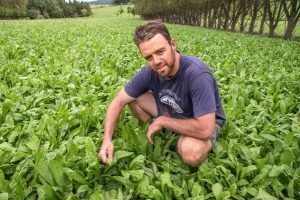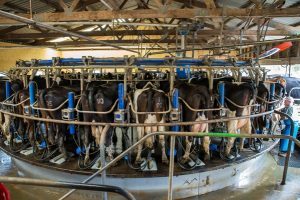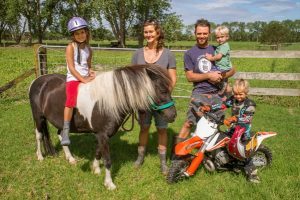After running a split-calving system for 20 years the Hewlett family moved to an extended lactation system. Glenys Christian reports.
Northland dairy farmer, Graeme Hewlett, often talked about how an English exchange student once mentioned 500-day milking to him. But it wasn’t until his son, Logan, came home to share milk on their Mata farm that the idea turned into reality.
“We were running a DairyNZ System 4 operation and often drying the cows off when they were still doing good production,” Logan says.
He looked into Australian information on extended lactation systems and went across the Tasman to visit one of the most prominent researchers there, whose advice was not to move the whole herd over at once.
“But when the time came to inseminate the cows it was a case of do it now or wait another six months,” Logan says.
So they took the plunge four years ago, with the following months being “quite a nervous time”.

And to add some insurance he enlisted the help of nutritionist, Trish Lewis, to make sure the herd was getting enough protein.
“Otherwise they run to fat,” he says.
The farm had been running a split-calving system for the past 20 years with one herd calving on March 20 and the second on July 20.
“It wasn’t easy as the incentives are better now,” Logan says.
“But there was the benefit of being able to bring carryover cows from one herd into the other.”
‘It’s all about efficiency and dialling the right amount of feed in. It’s a delicate balance because you have to keep milking.’
The average lactation length for their 460 cows, milked on 144 effective hectares, is now 480 days and in their first extended milking period they averaged 750kg of milksolids (MS) each.
“Some cows hit the 480 days with no problems at all, but some get to 360 and start to put on body condition so we’re trying to breed that out.”
Their replacement rate is about 22% with concentration on culling for production as well as high somatic cell counts, to deal with an ongoing issue.
“I’m trying to annihilate it this year.”

With milking for 18 months one season in three will deliver higher milk production of around 260,000kg MS while the following two are likely to average about 245,000kg MS. Last year they hit only 230,000kg MS.
“That was disappointing, but it was a tough season,” he says.
“It’s all about efficiency and dialling the right amount of feed in. It’s a delicate balance because you have to keep milking.”
The cows, split into two herds, receive 650 tonnes of maize silage a year, all grown on a leased runoff of 75 hectares just further north at One Tree Point. The crop was grown on the home farm until a few years ago with harvests of 18t/ha. But making the switch to the runoff, which had previously been used to graze their young stock, now sees that boosted to an average of 25t/ha.
From 400-500t of palm kernel is used along with varying amounts of dried distillers grain (DDG), canola and cottonseed depending on the price on the day, which Logan tracks carefully. Palm kernel inputs may come back a bit in the coming season as Fonterra’s Fat Evaluation Index (FEI) demerit points system is introduced in September.
“In winter it can be a bit hard to manage because you’ve got to be sure the cows are getting enough protein,” he says.
From 20 to 120 grams of urea per cow per day will also be added to the mix, which Logan has included all this season. He also keeps a very close eye on trace mineral inputs at crucial times of the year.
“We really look after the cows and there don’t appear to be any animal health issues.”
Under what’s now a DairyNZ System 5 operation the herds are fed on an uncovered feed pad, concreted 15 years ago, which can comfortably hold 300 cows. A J F Stoll mixer wagon was bought three years ago with molasses sometimes also added into the mix. Maize grain is fed to the cows through the in-dairy feeding system in the 32-bail rotary which is 35 years old.
“It’s in good nick,” Logan says.
“There’s no Protrack so that’s on the list.”
Without milk metering they herd test six times a year.
“You really want a cow doing 650kg MS at 305 days milking,” he says.
“That’s the trigger point.”
The herd average is sitting at about 580kg at that time with 870kg MS over a full lactation of 480 days. But the highest producers can achieve from 1000kg up to 1300kg.
“It’s improving every year.”
Extended lactation does mean long hours milking totalling eight and a half hours a day at the peak. One herd will leave their paddock fitted with a Battlatch at 4am to come up to the dairy, followed by the second herd. Then afternoon milking begins at 2.30pm.
Through summer milking runs from 5 to 8.30am then from 2.30 to 4.30pm.
“I’ve moved the afternoon milking forward by half an hour as the milk volumes increased so we were always finished by 6pm,” he says.
He’s helped by a 2IC, who lives onfarm, and they’re due to be joined by a Filipino worker who will live on a neighbouring property.
“We do well on Fonterra’s capacity adjustment charge because we produce a lot of milk in the shoulders of the season, helped by our long tail-off from peak,” he says.
“But the downside is we are more vulnerable to lower payouts.”
Cows when they are dried off are usually around body condition score (BCS) 5 to 6.
“Only if it’s bone dry will we give them supplements,” he says.
Usually they will follow the milking mobs around eating the pasture they leave behind.
With high fertility levels they only put on about 150 units of straight nitrogen a year in bulk applications to capture the main grass growth periods. Ammo 31 or 36 will usually go on twice in the winter on the advice of farm consultant, Nico Mouton. They have a 35ha effluent area where a travelling irrigator and pods are used on chicory during the summer. Effluent solids are spread on the rest of the farm with a solids spreader.
Kikuyu paddocks will be mulched in autumn and Logan will top any other paddocks which require it from October through to summer. He hopes their cropping regime will see remaining kikuyu work its way out of their pastures.
About 38ha of chicory has been grown this summer to feed the two milking herds but will be reduced to 20ha for the next two years of his three-year cycle. It’s been used for the last five years after it was first tried alongside turnips.
“We used to struggle to get 9t/ha with the turnips,” he says.
A late crop where there were issues with fungi causing light sensitivity problems for the cows was the final nail in the coffin.
“I thought it was facial eczema at first, and I had noticed that there was a drop in milk quality when the cows moved from chicory on to turnips,” he says.
While chicory doesn’t provide a great deal more drymatter its high protein levels are a big benefit in their pasture renovation programme which covers the whole farm every five years. And when it’s sprayed out just in case there isn’t as much regrowth as he would like he will include some of his perennial mix, chosen because of the highest star ratings in DairyNZ’s forage value index (FVI).
“Its long roots are tapping down into a whole different level of the soil,” he says.
Logan wasn’t immediately attracted home to the farm after finishing school. He completed a diesel mechanic’s apprenticeship, going on to run Cummins New Zealand’s workshop in Whangarei.
“I was in love with trucks, diggers and tractors but having a family changed my mind,” he says.
“I was going off to work at six in the morning and coming home at seven at night.”

Six years ago the opportunity presented itself to come home and be the fourth generation to farm there. He had met and married Michelle, an early childhood teacher, who had been a jockey in her native Australia, and they already had daughter Emma-Jane, now 7. She has two brothers, Nate, 5, and Carter, 2, with another sibling on the way.
Since Logan’s been back on the farm he’s moved calving dates to March 1 and August 1, continuing the 50:50 split between the two. They’ve always used LIC semen and switched for the last two matings from the Forward Pack to the High Input team to better tailor calves to their requirements.
“Production Worth is really what we’re after,” he says.
They AI for eight weeks then put Hereford bulls out for a week with the cows.
“But I’m considering if we should wean ourselves off using the bulls because they’re not picking up much.”
Their heifers are AI’d as well with crossbred semen for ease of calving, before Jersey bulls being run with them.
Michelle helps with the calf rearing, taking a break from her beauty product business, Dream Cream, as used by television personality Toni Street. The calves go first into a shed converted from an old wintering barn three years ago which can hold 90 at a time. They’re placed 12 to a pen with teat feeders giving access to milk pumped into a tank on a trailer at the dairy to be brought to them. A small amount of Moozlee is fed in the first week which ramps up as they grow.
Spring-born calves will generally stay inside for eight weeks but those born in autumn can be let outside in four if it’s nice weather. At 12 weeks they go to the nearby 22ha runoff which Graeme and Shirley visit every second day to check on their progress. They don’t weigh young stock regularly, but scales are another item high on Logan’s list of purchases.
Around 150 bull calves are also raised which can be sent to sales at Kauri or Wellsford or sold direct to a bull farmer friend at Tangiteroria.
A 1.8ha Queen Elizabeth II Trust covenant was put in place 15 years ago with other trees planted along waterways on the farm. More riparian planting is planned in the future.
Two years ago Logan was approached by Northland Dairy Development Trust (NDDT) chair, Penny Smart, to become a trustee.
“I like to give back,” he says.
“We’re a trust run by farmers facilitating independent, robust research that is area-specific and that farmers can trust.”
For the coming season it’s hoped that Logan and Michelle will be able to buy the farm with his parents taking a well-earned retirement either on the property or close by.
“It’s been a slow, arduous task as any farm succession planning is,” Logan says.
His sister, a nurse, is married to a Putaruru dairy farmer while one brother, an accountant, lives in Melbourne, and the other, a joiner, makes San Francisco his home.
“I want to relieve Mum and Dad of the stress of farming after 50 years,” Logan says.
“And I’ll be able to keep Dad busy when and where he wants to.”
Four things to think about
Extended lactation farming “is not just a coasting system,” Logan Hewlett says.
He believes there are four areas dairy farmers need to think about very carefully before contemplating the move.
- Do you have the facilities, such as dairy, feedpad and feeding system, to milk year-round?
- Is your breed of cow suitable to milk on for extended periods? He believes F11 to F13 Friesians are ideal.
- Is you staffing adequate? If you’ve already got a winter milk system under way there won’t need to be many changes, he believes, apart from there being four calvings every three years as opposed to six. But there’s much more time spent in the dairy milking.
- You must be able to grow and maintain as much quality grass and summer crops as possible so there’s not such a need to rely on feeding supplements.
Key points
Location: Mata, south of Whangarei
Owners: Graeme and Shirley Hewlett
Lower-order sharemilkers: Logan and Michelle Hewlett
Area:170 hectares (144ha effective), 22ha nearby runoff where young stock are grazed, leased 75ha runoff at One Tree Point
Herd: 460 Friesian-Friesian-cross, Breeding Worth (BW) 97/45, Production Worth (PW) 129/67, 99 percent recorded ancestry
Production: 2016/17 230,000 kilograms of milksolids (MS), target for 2017/18 260,000kg MS
Supplements: 650 tonnes maize silage grown on leased runoff, 400-500t of palm kernel, dried distillers’ grain (DDG), canola or cottonseed depending on price
Dairy: 32-bail rotary with in-dairy feeding system.
Average FWE (last 6 years): $4.59
Average FEW for the 3 years of extended lactation: $4.46
What happens when?
First herd Second herd
Year one Calved autumn Calved spring
Year two Calved spring
Year three Calved autumn
Year four Calved autumn Calved spring





